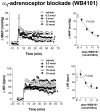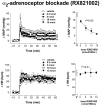Both α1- and α2-adrenoceptors in the insular cortex are involved in the cardiovascular responses to acute restraint stress in rats
- PMID: 24404141
- PMCID: PMC3880272
- DOI: 10.1371/journal.pone.0083900
Both α1- and α2-adrenoceptors in the insular cortex are involved in the cardiovascular responses to acute restraint stress in rats
Abstract
The insular cortex (IC) is a limbic structure involved in cardiovascular responses observed during aversive threats. However, the specific neurotransmitter mediating IC control of cardiovascular adjustments to stress is yet unknown. Therefore, in the present study we investigated the role of local IC adrenoceptors in the cardiovascular responses elicited by acute restraint stress in rats. Bilateral microinjection of different doses (0.3, 5, 10 and 15 nmol/100 nl) of the selective α1-adrenoceptor antagonist WB4101 into the IC reduced both the arterial pressure and heart rate increases elicited by restraint stress. However, local IC treatment with different doses (0.3, 5, 10 and 15 nmol/100 nl) of the selective α2-adrenoceptor antagonist RX821002 reduced restraint-evoked tachycardia without affecting the pressor response. The present findings are the first direct evidence showing the involvement of IC adrenoceptors in cardiovascular adjustments observed during aversive threats. Our findings indicate that IC noradrenergic neurotransmission acting through activation of both α1- and α2-adrenoceptors has a facilitatory influence on pressor response to acute restraint stress. Moreover, IC α1-adrenoceptors also play a facilitatory role on restraint-evoked tachycardiac response.
Conflict of interest statement
Figures




References
-
- Alves FH, Gomes FV, Reis DG, Crestani CC, Correa FM, et al. (2013) Involvement of the insular cortex in the consolidation and expression of contextual fear conditioning. Eur J Neurosci 38: 2300–2307. - PubMed
-
- Dampney RA, Horiuchi J, McDowall LM (2008) Hypothalamic mechanisms coordinating cardiorespiratory function during exercise and defensive behaviour. Auton Neurosci 142: 3–10. - PubMed
-
- Campeau S, Watson SJ (1997) Neuroendocrine and behavioral responses and brain pattern of c-fos induction associated with audiogenic stress. J Neuroendocrinol 9: 577–588. - PubMed
-
- Crestani CC, Tavares RF, Alves FH, Resstel LB, Correa FM (2010) Effect of acute restraint stress on the tachycardiac and bradycardiac responses of the baroreflex in rats. Stress 13: 61–72. - PubMed
Publication types
MeSH terms
Substances
LinkOut - more resources
Full Text Sources
Other Literature Sources

